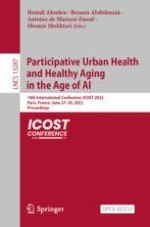
Open Access 2022 | OriginalPaper | Chapter
SAATHI: An Urdu Virtual Assistant for Elderly Aging in Place
Authors : Anand Kumar, Ghani Haider, Maheen Khan, Rida Zahid Khan, Syeda Saleha Raza
Published in: Participative Urban Health and Healthy Aging in the Age of AI
Publisher: Springer International Publishing
Activate our intelligent search to find suitable subject content or patents.
Select sections of text to find matching patents with Artificial Intelligence. powered by
Select sections of text to find additional relevant content using AI-assisted search. powered by